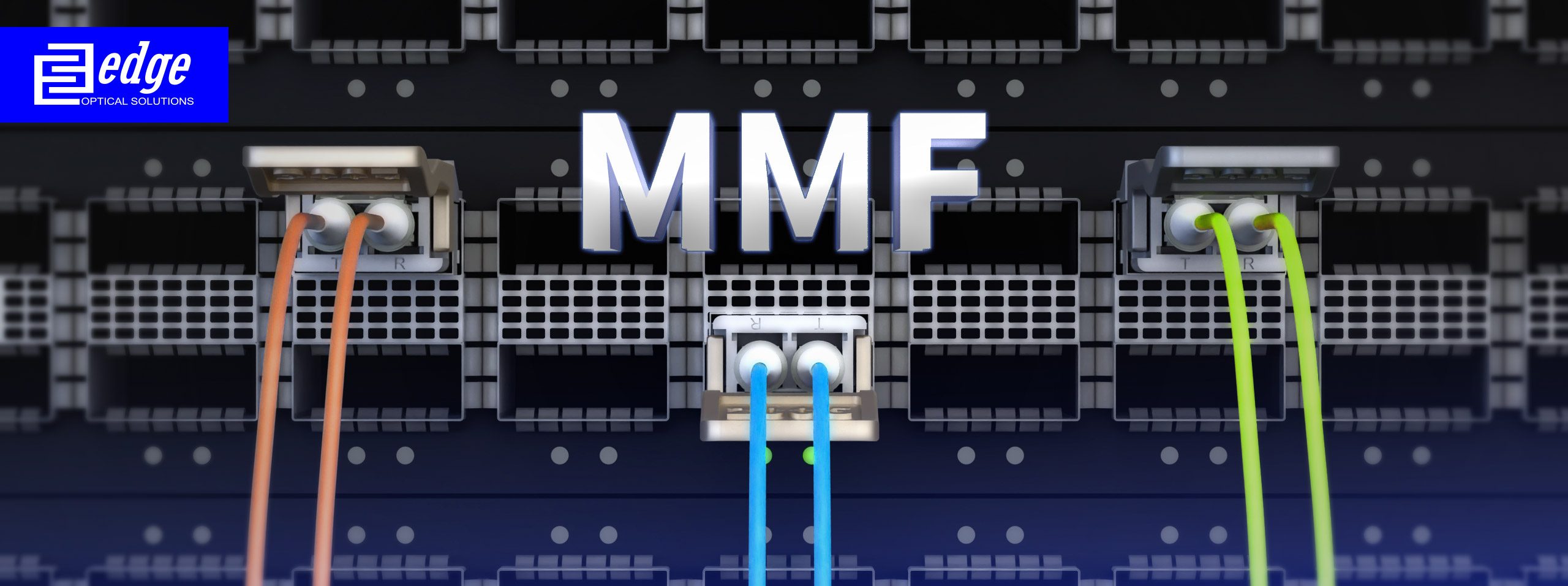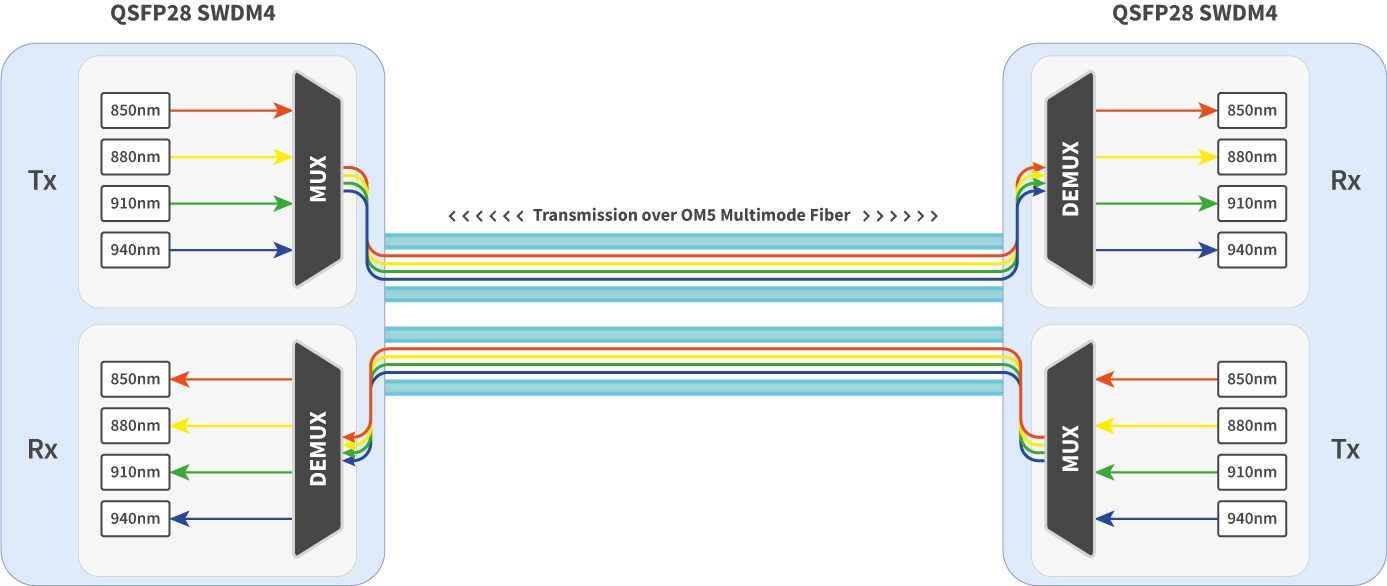
OM1 vs OM2 vs OM3 vs OM4 vs OM5 Multimode Fiber: Understanding the Differences
In today’s highly connected world, where infrastructure like data centers and enterprise server rooms are constantly evolving, OM1, OM2, OM3, OM4, and OM5 multimode fiber play a crucial role. Whether you are a seasoned IT Architect or a curious newcomer to the realm of fiber optics, this article aims to navigate you through OM1 vs OM2 vs OM3 vs OM4 vs OM5 multimode fiber types covering speed, transmission distances, typical applications, a detailed technical comparison and frequently asked questions about this topic.
To recap Optical Fiber can be divided into Multimode Fiber (MMF) and Single-Mode optical fiber (SMF).
Multimode Fiber (MMF) has a core diameter, typically 50–100 micrometers, has ability to transfer multiple modes of light through the fiber core, uses lower-cost electronics (LED, VCSEL) operates at the 850 nm and 1300 nm wavelength and is used for short distance interconnections (up to 550m) typically within the same building.
Single-Mode Fiber (SMF) has much smaller core diameter 8–9 micrometers, has ability to transfer only one mode of light thought the core, uses higher cost electronics (DML and EML lasers) operating at the 1310 nm and 1550 nm wavelength which result in lower attenuation and dispersion parameters, which makes SMF suitable for long distance interconnections (up to 100km, or even with use of optical amplifiers and dispersion-compensating devices distances can be in thousands of kilometers).



ISO/IEC 11801 defines the OM1, OM2, OM3, OM4, and OM5 types of multimode fiber. It also lists the key technical requirements for each type. In the two tables above, we’ve summarized the main differences between OM1, OM2, OM3, OM4, and OM5. These differences include the maximum distance and speed, the standard release date, the modal bandwidth, the size of the fiber core, the color of the fiber jacket, and the typical applications from data rate perspective. Most multimode fiber types used today are OM3/OM4 and OM5, but there are still older network infrastructures, where cables inside buildings were laid a long time ago that use OM1, OM2 multimode fiber.

OM1 Multimode fiber type was the first MMF version to be standardized in 1989. It has a larger core diameter (62.5 µm), an orange fiber jacket that is standard in the industry, and an Light-Emitting Diode (LED) light source. It was usually used for 100M Ethernet transmission links, but it is capable of transmitting 1G Ethernet up to 275 meters and 10G Ethernet up to 33 meters.

The OM2 fiber type of multimode was standardized in 1998. It still uses LEDs as its light source, but its core, when compared to OM1, is smaller – 50 µm in diameter. The fiber jacket is the same color as OM1 fiber – orange. Most of the time, OM2 fiber was used for 1G Ethernet interconnection in distances up to 550 meters. However, recent tests with the latest hardware have shown that 1G Ethernet can reach up to 2 km under optimal conditions. OM2 fiber can also be used for 10G Ethernet, though with a distance limitation of up to 33 meters.

In 2003, the OM3 fiber type was standardized and is closely linked to the IEEE 802.3 10GbE Ethernet standard. It has a core diameter of 50 µm and a modal bandwidth of 2000 MHz/km. Its main advantage is that it uses laser-optimized multimode fiber (LO-MMF), which is designed to work with vertical-cavity surface-emitting lasers (VCSEL) and was made to support faster networking seeds such as 10G, 40G, and 100G Ethernet. Typically OM3 fiber is used for 10G Ethernet and can make connections up to 220 meters long. However, it can also be used for 25G Ethernet connections up to 70 meters long and 40G/100G Ethernet connections up to 100 meters long.

The OM4 fiber type was standardized in 2009, and compared to OM3 fiber , it has a higher modal bandwidth of 4700 MHz/km, while OM3 has a modal bandwidth of 2000 MHz/km. This means that OM4 can send more data than OM3 over the same distance. It leads to the fact that OM4 has better attenuation (OM3 is 3.5 dB/Km and OM4 is 3.0 dB/Km) and dispersion parameters, which allows for longer distances between connections. With OM4 fiber, you can transmit a 10G Ethernet signal up to 400 meters, a 25G Ethernet signal up to 100 meters, a 40G Ethernet signal up to 150 meters and a 100G Ethernet signal up to 70m OM3 and 100m OM4.

OM5 fiber, also called Wide Band Multimode Fibre (WB-MMF), is the newest type of multimode fiber cable standard. It was released in 2016 and is made to support short wavelength division multiplexing (SWDM) transmission. Compared to OM4, the OM5 standard calls for a modal bandwidth of both 4700 Mhz/km at 850 nm and 2470 Mhz/km at 953 nm. What does it mean? It means that OM5 will work much better with multi-wavelength SWDM transceivers (850 nm to 940 nm) like 40 SWDM4, 100G SWDM4, and 400G-BD4.2, but won’t add any extra value when used with standard 1G, 10G, 25G, 40G, and 100G transceivers working at 850 nm range.
Multimode fiber (MMF) is a key part of building short-range connections in data centers or enterprise networks. It is important to know the differences between OM1, OM2, OM3, OM4, and OM5 multimode fiber types and how they are usually used in order to build networks that are both cost-effective and reliable.
VCSEL vs LED - what are the differences?
What is effective modal bandwidth (EMB)?
OM3 vs OM4?
OM4 vs OM5?
What is LOMMF - Laser-Optimized Multimode Fiber?
OM1, OM2, OM3, OM4 and OM5 - what does OM stand for?
Are OM1, OM2, OM3, OM4, OM5 backwards compatible?
What is multimode fiber max distance?
While we’re on the subject of multimode fiber, we can suggest you to read the following articles:
- Can we connect multimode SFP with Single mode fiber?
- MTP MPO cables – All Basics You need to know
- 1G and 10G SFP BiDi Transceivers on Multimode fiber
Or check out our:

